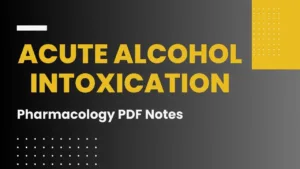Acute Alcohol Intoxication

Content
Alcohol
• Acute alcohol intoxication
• Methanol poisoning and its treatment
• Mechanism of disulfiram
• Drugs used for the treatment of alcohol dependence
Intended Learning Outcomes
At the end of this lecture, student will be able to
• Explain acute alcohol intoxication
• Explain methanol poisoning and its treatment
• Outline the mechanism of disulfiram
• List the drugs used for the treatment of alcohol dependence
Acute alcohol intoxication
Life Threatening signs of alcohol poisoning include:
Inability to Wake up
Irregular breathing (10 second or more between breaths)
Vomiting
Seizures
Slow breathing (fewer than 8 breaths per minute)
Hypothermia (Low body temperature), bluish skin color, paleness
• 600ml of pure alcohol in 70 Kg bodyweight: Fatal effect
• Coma due to CNS depression, severe hypoglycemia
Treatment
• Maintenance of vital functions
• Thiamine 100 mg (Bolus IV)
• Glucose 50% 50 ml IV for hypoglycemia
• MgSO4 2-4g IV over 1-2 hrs
Chronic alcoholism
Neuropsychiatric syndromes
• Korsakoff’s psychosis, hallucinosis, suicidal tendencies, Wernicke’s encephalopathy
Nutritonal deficiencies
• Polyneuritis due to thiamine deficiency & anaemia
Organ damage leading to
• Hepatic cirrhosis, chronic pancreatitis, cardiomyopathy, optic nerve degeneration
Alcohol dependence
• Precise mechanism not known
• Upregulate NMDA receptor & voltage sensitive calcium channel
• Down regulate GABAA mediated ressponses
• Treatment:
– Detoxification
– rehabilitation
Drugs for Alcohol dependence
• Aversion drugs: Disulfiram, citrated Ca cyanide
• Opioid antagonist: Naltrexone, Nalmefene
• Dopamine Antagonist: Tiapride
• NMDA Antagonist: Acamprosate
• Supporting drugs: Lithium, carbamazepine, topiramate
Disulfiram
• 12 hours alcohol free
• 500 mg as single daily dose for 1-2 weeks
• 125 – 250 mg OD as maintenance dose
• Continued upto 1 year
• Inhibits aldehyde dehydrogenase
• Inhibits dopamine beta oxidase
Alcohol
• Drug interactions
– Inhibits metabolic degradation of warfarin, theophylline, benzodiazepine, carbamazepine,
tricyclic antidepressants
• contraindications
– Hepatic and circulatory diseases
– Uncontrolled DM
– Alcoholics with obvious personality changes
Methyl Alcohol
Pharmacological Actions
• Initial symptoms similar to ethanol
• Later symptoms due to:
• CNS depression
• Acidosis: because of formic acid and other organic acids
• Toxic effects of formaldehyde & formic acid on retinal cells
• Delayed symptoms
• Headache vertigo, nausea, vomiting
• Severe abdominal pain
• Dyspnoea
• Motor restlessness
• Bradycardia
• Coma followed by death
• Preceded by blindness
Treatment
• Hospitalization & nursing care
• Gastric lavage, activated charcoal
• Treatment of acidosis/ hypoglycemia
• Inhibition of methanol metabolism: ethanol, fomepizole
• Promotes metabolic degradation of formate
• Folinic acid 1mg/Kg IV wih folic acid img/Kg IV 4 hourly for 6 doses
• Hemodialysis in severe case
FAQs
- What is considered binge drinking?
- Binge drinking is typically defined as consuming five or more alcoholic drinks within a short timeframe, usually within two hours.
- How does alcohol affect mental health?
- Alcohol can contribute to mental health issues such as depression and anxiety, and excessive consumption may exacerbate pre-existing conditions.
- Can someone recover from alcohol dependence?
- Yes, with the right support and treatment, individuals can recover from alcohol dependence and lead fulfilling lives.
- Are there legal consequences for providing alcohol to a minor?
- Yes, providing alcohol to a minor is illegal and can result in legal repercussions.
- How can communities support those struggling with alcoholism?
- Communities can provide support through education, access to resources, and fostering a non-judgmental environment for individuals seeking help.
Summary
• Chronic alcoholism leads to Korsakoff’s psychosis, hallucinosis, suicidal tendencies, wernicke’s encephalopathy Hepatic cirrhosis, chronic pancreatitis, cardiomyopathy, optic nerve degeneration
• Regular consumption of alcohol associated with hypertension and conduction defects
• Methanol poisoning: Coma preceded by blindness
• Hemodialysis in severe case of methanol poisoning
For Detailed PDF Notes Click on Download Button



